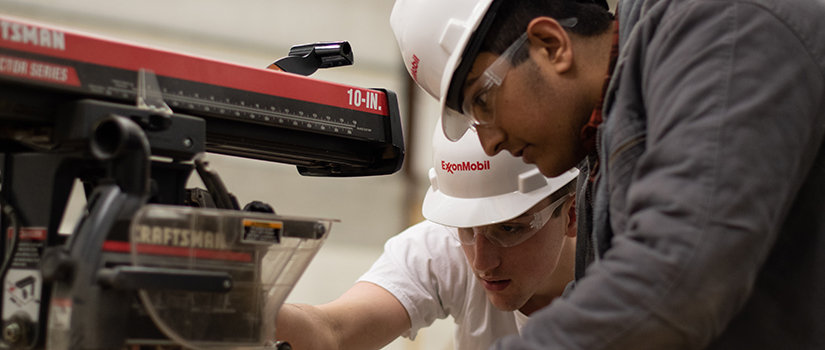A behind the scenes look at the Tiger Burn project
By Abe Danaher | November 21, 2019
With one hand on the microphone and another steadying the camera, I stand ready to
finish my video setup. To my left, a two-by-four clangs to the floor as the hum of
the saw that sent it there slows to a whisper, and hardhats emblazoned with “Exxon-Mobil”
shimmy away to pick it up. I push the mic in, flip the camera on, and look up.
Gabe Carrilho is gone.
In a warehouse off Catawba Street, 50 UofSC College of Engineering and Computing students
are building a 30-foot-tall wooden tiger that will be burned on November 25 to kick
off South Carolina – Clemson rivalry week. Thousands will gather that night, donning
their favorite garnet gear to watch the team’s creation burn to ash. Already, just
twelve hours of work in and nearly a month away from the Tiger Burn event, the tiger
has bones.
*** Broken a:231565 Engineering_and_computing: Tiger Burn 2019 video ***
Pushed against the walls of the warehouse are two de-clawed boxes of equal size. To
the right stands a square frame, with support beams fastened across it like a rib
cage. In the middle of the room is the makings of a tiger head, and beside it a football
huddle. I scan the lower two inches for Carrilho’s white Nike Air Force 1’s and find
them exactly where I expect to – the center of his team’s sneaker circle.
Five minutes later, the huddle breaks and Carrilho darts over to O’Dhori Prioleau – the president of UofSC’s American Society of Mechanical Engineers – and tells her
of the new adjustment. One of the boards for the head has been cut two feet short,
I overhear him tell her, but it’s no problem. It’ll add perspective to the head; a
tapering look. His calm voice and smile enforce the message.
He turns toward the camera.
“I’m sorry, I’m sorry!” he says as he runs over. “I just had to speak to the project
leads – something came up, but honestly, I think it worked out for the best.”
He slides into the chair as the students behind him go back to work.
Building a wooden tiger just to burn it down days before the South Carolina – Clemson
football game is nothing new. But, the look, feel and process of building this year’s tiger is.
As co-project leads, Carrilho and Christian Grein – a junior mechanical engineering
major – have implemented a management system to increase the efficiency and organization
of the project. They've split the 50 interested students into two teams – a design
team and a construction team – and within each team, implemented multiple project
leads that were responsible for the safety and management of their team members. Then,
they implemented four shifts within the construction team, with each shift responsible
for creating an individual part of the tiger.
The changes have proven to be spot-on. The frames are already built, the teams are
a full day ahead of schedule, and Carrilho has been able to take a deep breath.
“At this rate, we can build two tigers in the amount of time we have,” he says.
Without the stress of worrying whether the tiger will get completed on time, the team
has been able to experiment more than they ever have before. When it was Prioleau’s
turn to slide in front of the camera, she described this year’s tiger as “bobblehead-like,”
hinting that it will have a skinnier body and bigger head than in years past. Carrilho
was even more direct.
“This design hasn’t been done before,” he says. “We are changing it up, we are being
risky, but I think it’s going to pay off and set our team apart from last year’s team.”
With added weight on the head resulting from the new design, students have been using
basic math and physics material learned in their introductory engineering courses
to validate the design’s safety. Ross McDaniel, a sophomore mechanical engineering
major and a lead on one of the construction shifts, says he was “surprised” to see
how much in-class material made its way into this out of class project. He explained
the process of conducting stress analysis and momentum simulations to make sure everyone
will be safe even after the tiger is aflame.
Outside of maintaining safety, though, the team’s goals are simple: they want this
tiger to become engulfed in flames faster and to burn longer than ever before. For
the first time in the 99-year history of the event, firemen had to extinguish last
year’s fire. This year, the team hopes to keep the firemen even busier by using a
combination of hay, t-shirts, lighter fluid and more wood pellets to set new tiger
burn records.
“If it burns how we expect it to, I will be really excited,” Prioleau says.
For Carrilho, overseeing a project of this magnitude hasn’t been easy. But through
the process he helped implement and the simple mindset of “this just has to happen,”
Carrilho is confident that the thousands gathered at the Greene street fields November
25 will not be disappointed. He already hears the crowd’s raucous cheers, sees flames
shooting high into the sky, and knows exactly what will be running through his head.
“There might be a little disappointment there because it is a lot of man hours to
build this tiger,” he says, before the left corner of his top lip lifts into a mischievous
smile. “But at the end of the day, that’s an ugly mascot so it just needs to come
down.”
